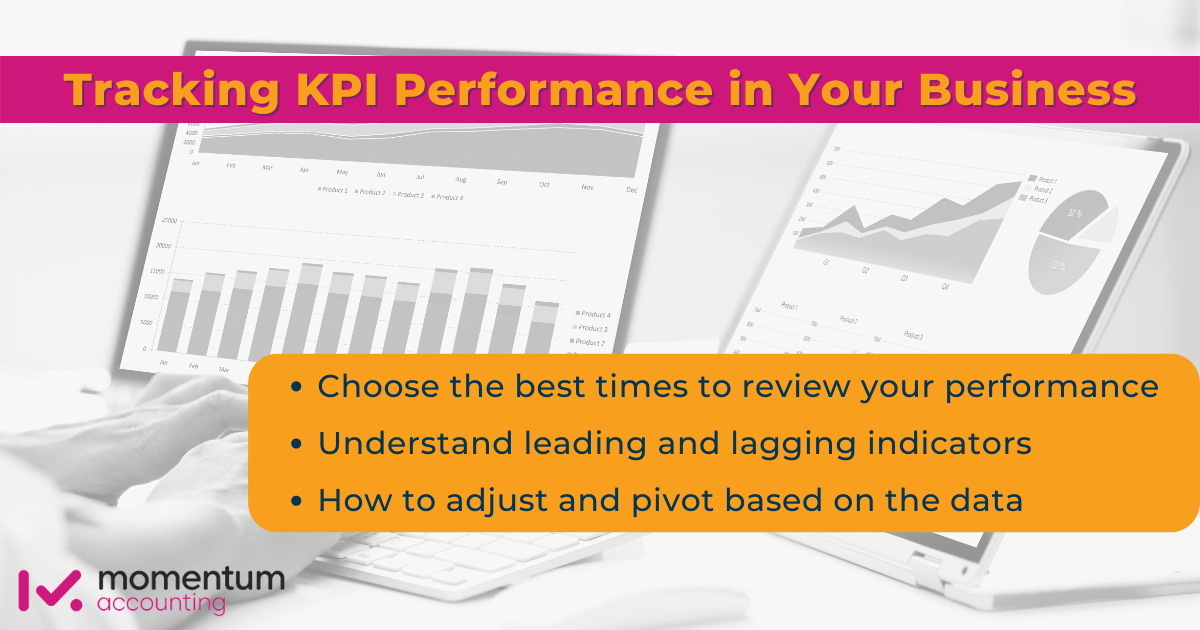
There is no shortage of content available online that tells you which KPIs are better to track in your business, which you should avoid, and even how to calculate each one of these metrics.
However, there are nearly as many resources showing you the day-to-day tracking of your performance based on these key performance indicators.
In this article, you’ll see:
- Choosing the best times to review your performance
- Understanding leading and lagging indicators
- How to adjust and pivot based on the data
How (and when) to Review Performance
Checking your sales each day is fun, but it doesn’t really give you an indicator of how your sales team is doing.
On the other hand, reviewing one month’s sales and comparing it to the same period last year is potentially a strong indicator of team performance. The point?
Tracking KPI performance involves two types of time — the amount of time you track each metric and the timeline of reviewing those metrics.
- Note: some metrics require more frequent, even hourly, checking. For instance, an agency offering a 72 hour sale for a particular add-on service for existing clients. If the primary marketing vehicle for the sale is email, you and other relevant members of the team will likely check those metrics multiple times per day.
Turning the Subjective into Action
There are obviously a lot of subjective elements to KPIs based on the business, team, and circumstances. That said, after you have the KPIs to track, create a loose actionable plan based on the following time frames:
- Weekly: These are fast-moving initiatives where tasks and actionable items need to be changed more frequently. An example: ad campaigns.
- Monthly: It’s here where many of the guiding KPIs of your business reside. Things like, quick review of sales and marketing metrics as well as big expenses (i.e. contractors, ad spend)
- Quarterly: A quarterly review is great for KPIs and line items that may not otherwise show a trend if you review them any sooner. One example is payroll. Payroll metrics (revenue/profit per employee) show whether or not your team is bloated, you need to hire, or if there is something funny going on with your payroll-related expenses.
Key takeaway: List your KPIs, and see how often you need to review them. It’s not set in stone, and will likely change over time. In other words, don’t be afraid of the trial and error process.
Recognizing Potential Indicators of Performance
Some additional terms that you never hear mentioned when many resources talk about KPIs are leading and lagging indicators.
- Leading indicators are input oriented and are easier to impact results, relatively speaking.
- Lagging indicators are outputs, often connected to leading indicators.
Leading indicators are often harder to measure than lagging indicators. Lagging financial indicators in your business include things like:
- Sales
- Cash flow
- And profit
In other words, the numbers and data you see when a period is over.In the case of our lagging examples, leading data include things like:
- New leads/prospects
- New contracts signed
- Invoices sent out to clients
Key takeaway: Understand the relationship between your hard data (i.e. sales, number of customers) and the metrics that affect them (prospecting, deliverables).
How to Adjust and Pivot (Based on Tracked Performance)
Why is any of this important?
If you see lagging indicators show something important, check your leading indicators (and in some cases, vice versa). It’s here we see the power of reviewing the right KPIs at the right time, highlighting potential issues and using the data to get to the bottom of them.
Example of Lagging to Leading KPIs
You notice operating cash became tight last month (lagging indicator).
During your monthly review, you dig into the leading indicators that affect cash flow. You don’t notice a drop in prospecting or closes. You dig deeper and find a problem lying in your accounts receivable. Too many unpaid invoices rolling around in the wild.
Potential actions:
- Send invoice reminders
- Set up ACH payment agreements with all incoming clients (and potentially current clients)
- Increase line of credit to keep things moving
Example of Leading to Lagging KPIs
To flip the indicators on their head, let’s say you’re aggressively growing your business. It takes closer tracking, and more frequent reviews. You won’t know the results until those lagging indicators come into view.
However, if you set KPIs, it’s easier to track and see if you’re going to hit goals.
- Example: You want to grow 10% month-over-month.
Leading indicators include reaching out to decision makers (via LinkedIn, email, and so on). That outreach leads to X conversations, with a certain conversion rate becoming new clients.
For the sake of ease, let’s say 1000 people reached, 100 conversations, 10 new clients.
To meet the goal, you need to reach 100 more people each month. Based on your current conversion rate, that’s 11 new clients in the month — your +10% goal.
You and your sales team/manager decide to review the prospecting KPIs each week. After week two, you’ve reached out to 500 people, short 50. You’d figure out the bottleneck.
- A team member?
- Not enough lead data?
- You get the idea
This is scrutinizing the leading indicators, to better ensure you’ll hit your lagging indicator goals.
Key takeaway: A problem in the lagging, means you need to pivot and/or tweak the leading indicators. And the other way around.

Ready for KPI Reporting that Empowers Decisions?
At Momentum, we believe your data tells a story. It begins by giving the numbers an outlet to show you how your business is doing. KPIs, regular reporting, and expert insights turn your financials into the themes you need to improve your business.
From setting up the tech to track your KPIs to CFO and payroll services solutions, we’re ready to take your data and find the story you need for better decision making. Reach out to see if we’re a fit for your business today.


